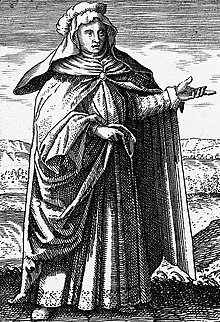Maria the Jewess

Maria the Jewess or Maria Prophetissa is considered the founder of alchemy and was the most important alchemist of the ancient world . The Jewish woman , who lived and worked in Alexandria (North Africa) between the 1st and 3rd centuries , was also an inventor .
It is to them that Carl Gustav Jung called the “Axiom of Maria Prophetissa”, which has been handed down in various versions: “One becomes two, two becomes three, and one of the third is the fourth; so the two become one. ”Or:“ The one becomes two, the two becomes three, and the third becomes the one as fourth. ”This sentence is apparently a number speculation from the Gnostic - Neoplatonic cosmology . The numerous attempts to interpret this sentence inspired Johann Wolfgang von Goethe to (seemingly) senseless " Hexeneinmaleins " in Faust .
Furthermore, the invention of various devices for the regulated heating of substances is attributed to her, such as the ash bath similar to the sand bath , the "hot bed" ( Venter equinum ) acting through fermentation heat and especially the heated water basin Bain-Marie , which is named after Mariae ( Marienbad ) her name is. Other inventions of it are the alchemical equipment Kerotakis and the first still Tribikos be; the sulphides that develop at the reflux apparatus still bear the name Maria's black today .
The Egyptian-born Zosimus from Panopolis , who wrote in Greek, mentioned her several times in his works on alchemy, but in some of his traditional versions of the text incorrectly identified her with Miriam , the sister of Moses . Sometimes she is even confused with Maria Aegyptiaca .
The alchemical tract Practica in artem alchimicam , which is preserved in the collective work Artis auriferae libri duo (Basel 1572), is circulating under her name . Another work is the late Excerpta ex interlocutione Mariae profetissae, sororis Moysis et Aaronis . A German version of the Latin treatise can be found in Opus Aureum A. de Villa Nova (17th century).
See also
literature
- Maria the Jewess . In: Lexicon of important chemists . Bibliographisches Institut, Leipzig 1988 ISBN 3-323-00185-0 , p. 290
- Renate Strohmeier: Lexicon of natural scientists and women of Europe. From antiquity to the 20th century. Verlag Harri Deutsch, Thun / Frankfurt am Main 1998, ISBN 3-8171-1567-9 .
- Maria Judaica. In: Hans Biedermann: Lexicon of the magical arts. Licensed edition of the 3rd improved and expanded edition. VMA-Verlag, Wiesbaden 1998, ISBN 3-928127-59-4 , p. 293.
- Chemical History Tour, Picturing Chemistry from Alchemy to Modern Molecular Science. Adele Droblas Greenberg Wiley-Interscience 2000, ISBN 0-471-35408-2 .
- Jette Anders : 33 alchemists. The hidden side of an ancient science. Past Publishing , Berlin 2016, ISBN 9783864082047 .
Web links
- Epónimos Científicos - Universidad CEU Cardenal Herrera (Valencia) (Spanish)
- Famous inventors - the forerunner of the pressure cooker
- The Prophetess Mary (Maria Prophetissa). In the German version of the 17th century, Dialogue with Aros.
Individual evidence
- ^ Lexicon of important chemists.
- ^ Opus aureum. Frankfurt am Mayn 1604, online edition of the Saxon State Library - Dresden State and University Library.
| personal data | |
|---|---|
| SURNAME | Maria the Jewess |
| ALTERNATIVE NAMES | Maria Prophetissa |
| BRIEF DESCRIPTION | Alchemist and inventor |
| DATE OF BIRTH | between 1st century and 3rd century |
| DATE OF DEATH | between 1st century and 3rd century |